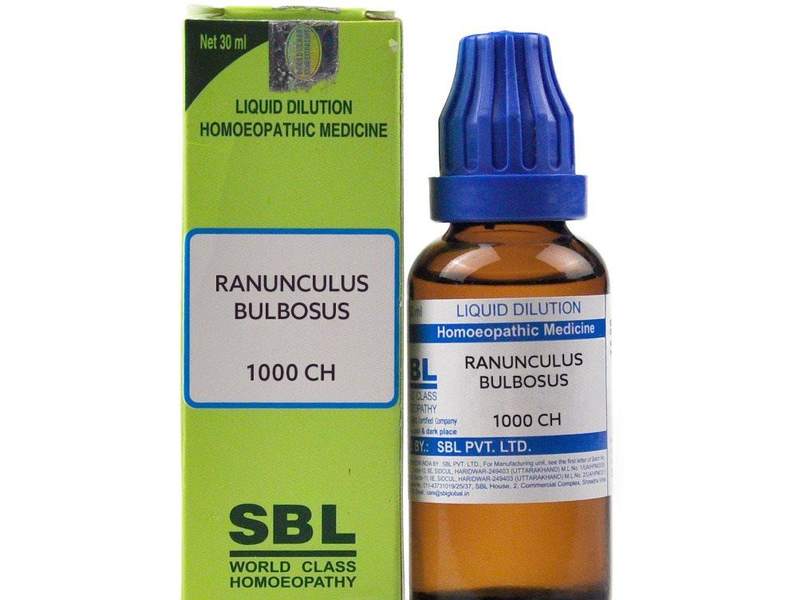- Thinking of complaints aggravates
- Stitching pains remaining in chest after pleurisy
- Day blindness with mist in front of eyes
Source: Vegetable kingdom
Synonyms: Bulbous crowfoot, Common field buttercup
Family: Ranunculaceae
Prover: Proving by Franz, Archiv fur Homoeopathische Heilkunst
Duration of Action: Short acting
Introduction and History: The caustic and pain producing properties of Ranunculaceae reach their highest expression in the Buttercups themselves. Ranunculus bulbosus forms a constituent of some arsenical plasters used to disperse cancers. It was proved by Franz. Some effects of its external application have been observed, while some symptoms were obtained from results of inhaling the fumes while collecting the plant or when the plant was burned.
Preparation and Parts Used: Mother tincture is prepared from the whole plant at the time of flowering.
Ailments From: Anger (slightest fit of, causes trembling and dyspnoea), change of temperature or weather, injury, alcohol.
Seat of Action (Pharmacodynamics): It is a pain remedy, affecting NERVES, muscles, eyes, serous membranes, CHEST, skin, fingers, toes and left side.
Physio-pathological Changes (Pathology)
- It acts especially upon the muscular tissues and skin, and its most characteristic effects are upon the chest walls, like pleurodynia.
- The root, the stalk, the leaves and the flowers when chewed cause a burning pain in the tongue; also pain in teeth and gums.
Characteristic Mental Symptoms (Psychology)
- Vanishing of thoughts on reflection.
- Obtuseness of senses.
- Patient has an angry disposition; quarrelsome.
Characteristic Physical Guiding Symptoms
Day blindness: Mist before the eyes. Pressure and smarting in eyeballs.
Muscular pains: Muscular pains about margins of shoulder blades in women of sedentary employment; often burning in small spots from needle work, typewriting, piano playing.
Pains: Stitching, sharp, shooting, neuralgic, myalgia or rheumatic pains in walls of chest, coming in paroxysms; excited or brought on by atmospheric changes; inflammatory; depending upon spinal irritation.
Pleurisy or pneumonia: From sudden exposure to cold, while being overheated or vice versa.
Corns: Sensitive to touch; smart, burn.
Intercostal rheumatism: Chest is sore, bruised; worse from touch, motion or turning the body, in wet stormy weather.
Shingles: Shingles preceded or followed by intercostal neuralgia; vesicles may have a bluish appearance.
Important Characteristic Features
Chest affections: It is a very useful medicine for chest affections. It has a creeping, crawling, tingling sensation. Inflammation of pleura. In pleural effusion, it is a very useful remedy when there is extreme soreness along the ribs, especially the lower ribs. Heavy, short breathing with oppression of chest in the evening. Sighing respiration. Pressure and constriction of the chest. Pressing, stitching, violent pains in the walls of the chest, in region of fifth and sixth ribs. Painful soreness on touch or pressure on the floating ribs. Chronic costal rheumatism. Soreness of ribs and of the attached supports of the diaphragm. Hydrothorax; pains in chest from adhesions of the pleura. Sensation of a cold, wet cloth on going into cold air. Rheumatic swelling of pectoral muscles with extreme soreness to touch. Pleurodynia with most violent cutting pains. Pulse is full, hard and rapid in the evening and slow in the morning. Worse in the evening, on inspiration, pressure, turning the body and cold air, motion, lying on left side.
Skin affections: Very useful medicine for skin affections. Dark, blue vesicles upon the skin. Horny scurf forms after the vesicles have opened. It has been used for vesicular eruptions; for burns; for herpes zoster; for pemphigus; for eczema. Fat burning, stinging, ulcers. Horn-like excrescences.
General Modalities
Aggravation: From cold damp air, draft of cold air, open air, change of temperature, change of position, alcohol, motion of arms, breathing, touch, eating, fright, vexation, anger, rainy and stormy weather, and standing.
Amelioration: From standing and sitting bent forward.
Remedy Relationships
Follows well: Kali-c, Rhus-t, Sep, Bry, Nux-v, Ign.
Antidoted by: Bry, Camph, Puls, Rhus-t.
Inimical: Sulph, Staph, Acet-ac.
Antidotes: Camph, Rhus-t, Anac, Puls, Bry.
Comparison
Itching in palate: Wyeth, Arund, Ran-b.
Dosage
- Mother tincture, in 10-30 drop doses in delirium tremens; third to thirtieth
potency generally. - In case of chronic sciatica, apply tincture to heel of affected leg.
Repetition: Repetition can be done in acute cases.
Therapeutic Value: Alcoholism, Brain affections, Chest pain, Corns, Diarrhoea, Eczema, Jaundice, Lung affections, Neuralgia, Rheumatism, Skin complaints, Writer’s cramps, etc.
Ask A Doctor
You can now consult our well qualified homeopathic doctor for homeopathic treatment of any kind of disease. The consultancy fee is only Rs 200/- . Post making the payment you will be asked about the disease and the symptoms of your disease. Based on your problem, the doctor will instruct you with the name of the medicine and the method of having the medicine. You can make the payment via Paytm App or your debit card. For more inquiry contact on the WhatsApp number - +919006242658


Comments are closed, but trackbacks and pingbacks are open.